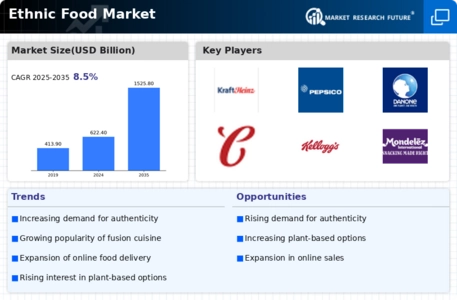The Ethnic Food Market is currently characterized by a dynamic competitive landscape, driven by increasing consumer interest in diverse culinary experiences and the globalization of food preferences. Major players such as Nestlé (CH), Unilever (GB), and PepsiCo (US) are strategically positioned to capitalize on these trends through innovation and regional expansion. Nestlé (CH) has focused on enhancing its product portfolio with authentic ethnic offerings, while Unilever (GB) emphasizes sustainability in sourcing ingredients, thereby appealing to environmentally conscious consumers. PepsiCo (US) has adopted a strategy of acquiring local brands to diversify its ethnic food range, which collectively shapes a competitive environment that is increasingly focused on authenticity and sustainability.
Key business tactics within the Ethnic Food Market include localizing manufacturing and optimizing supply chains to meet regional tastes and preferences. The market appears moderately fragmented, with a mix of large multinational corporations and smaller niche players. This structure allows for a diverse range of products, yet the influence of key players remains substantial, as they leverage economies of scale and brand recognition to maintain competitive advantages.
In August 2025, Unilever (GB) announced a partnership with local farmers in Southeast Asia to source traditional spices, enhancing the authenticity of its ethnic food products. This strategic move not only strengthens Unilever's supply chain but also supports local economies, aligning with the growing consumer demand for ethically sourced ingredients. Such initiatives are likely to bolster brand loyalty and enhance market share in the competitive landscape.
In September 2025, Nestlé (CH) launched a new line of frozen ethnic meals inspired by global cuisines, targeting busy consumers seeking convenience without sacrificing authenticity. This product line reflects Nestlé's commitment to innovation and its understanding of evolving consumer preferences, potentially positioning the company as a leader in the frozen ethnic food segment. The introduction of these meals may also serve to attract a younger demographic, further expanding its market reach.
In October 2025, PepsiCo (US) revealed its acquisition of a popular Mexican snack brand, which is expected to enhance its portfolio of ethnic offerings. This acquisition not only diversifies PepsiCo's product range but also allows for cross-promotion with its existing beverages, creating synergies that could lead to increased sales. Such strategic acquisitions are indicative of a broader trend where companies seek to integrate local flavors into their global brands, thereby enhancing consumer engagement.
As of October 2025, the Ethnic Food Market is witnessing trends such as digitalization, sustainability, and the integration of artificial intelligence in supply chain management. Strategic alliances among companies are increasingly shaping the competitive landscape, as partnerships enable shared resources and knowledge. Looking ahead, competitive differentiation is likely to evolve from traditional price-based competition to a focus on innovation, technology, and supply chain reliability, as companies strive to meet the demands of a more discerning consumer base.


















Leave a Comment